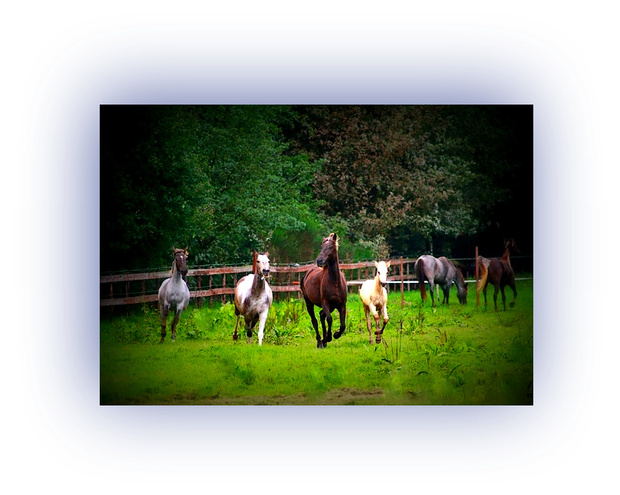About Rockies
About the Rocky Mountain Horse
**All horses must be DNA tested and examined by the RMHA for breed characteristics prior to breeding.
The established characteristics of the Rocky Mountain Horse are:
(1) The horse must be of medium height from 14.2 to 16 hands.
(2) They should have medium sized bones, with medium sized feed in proportion to the body, a span between the forelegs, a wide chest sloping 45-50 degrees to the shoulder.
(3) The horse must have a natural ambling, four-beat gait, with no evidence of pacing or trotting. When the horse moves, you can count four distinct hoof beats that produce a cadence of equal rhythm. The footfall is like a walk, left hind, left fore, right hind, right fore. Each individual horse has its own speed and natural way of going, traveling at 7-20 miles per hour. This is a natural-occurring gait, present at birth and it does not require training aids or action devices.
(4)The horse must be of good temperament and easy to manage.
(5) All Rocky Mountain Horses must have a solid body color. Facial markings are acceptable, so long as they are not excessive, and they may not have any white above the knee or hock.
Videos of the Rocky Mountain Horse's gait can be found on the RMHA website at www.rmhorse.com. The motion of the Rocky's gait causes the rider's pelvis to move in the same rhythm as when we walk. Because of this, many people with back problems and knee injuries find riding gaited horses to be therapeutic.
Rockies make wonderful riding horses, with strong hearts and good endurance. Many Rocky Mountain Horses are easy-keepers, but care must be taken to prevent them from becoming overweight, especially as they get older.
Even though the Rocky Mountain Horse breed is known as a gentle breed, we try to explain to people that they are still large animals, born with some degree of flight response. Even the quietest horse may spook at some time or another. Beginners should never assume a horse is bombproof. If the handler/rider is nervous, then odds are that the horse will be too. Any horse may decide to challenge you, and this breed is no exception. If you do not take the alpha role, your horse will!
Buyers should keep in mind that getting a Rocky is a huge commitment, and the decision needs serious contemplation. Choose your horse wisely, and base your choice on your experience level and what you wish to accomplish with the horse. We are honest with our clients because we love our horses and want them to go to "forever" homes. We do not want our horses to be bought and then re-sold because they were not what the new owners expected them to be.
It is important to know that when you bring your newly-purchased Rocky home, you need to allow a minimum of two to four weeks for the horse to get adjusted to its new environment and owner. During this time they may not act themselves. Be patient, kind, and forgiving during this adjustment period.
"Currently, we breed one or two Rocky Mountain Horses per year simply because we love them, and there is a growing demand for them. We wish good luck and miles of riding pleasure to everyone who purchases a Rocky."
..........Zjoske and Petra ...
...
HISTORY OF THE BREED
The breed originated from the Rocky Mountain Stud Colt of 1890. Little do we know of him, but he is the horse credited for the start of the breed. Oral history indicated he was chocolate-colored with a flaxen mane and tail, and he possessed a superior gait. He was bred to the local Appalachian mares, and a strong genetic line continued to produce the prized horses known today as Rocky Mountain Horses. The breed's basic genetic background went as far back as the Galloways from Scotland, the Hobbies from Ireland, and the Jennets from Spain. All of these gaited horses contributed to the gene pool.
However, we owe it all to Sam Tuttle and his stallion, TOBE (DOB 1942), for the survival of the breed. He was the person most responsible for keeping the line going. TOBE produced many offspring, but only five of his sons were best known as founding sires, and registered with the RMHA. They were Sewell's Sam, Maples' Squirrel, Yankee, Kilburn's Chocolate Sundown, and Sam Clemons' Tim. Today, the percentage of TOBE blood in our horses is still considerable. The breed is very young and horses with 50% TOBE in their blood lines still can de found.
...
